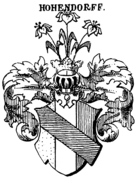Hohendorff (noble family)
Hohendorff , also Hohendorf, is the name of an originally Magdeburg noble family , which spread early to Brandenburg and East Prussia , and finally to Denmark .
history
The family borrows its name from the Hohendorf family house of the same name near Neugattersleben , where it first appeared in documents in 1147 with Vulradus and his son Otto.
Since 1339 joined relatives in Brandenburg, mainly in the country Lebus on, and since 1384 also in the later East Prussia, where Hans and Jacob, from Elblag Ordenskomtur Ullrich Fricke invested were.
The family owned Falkenhagen (1472), Körnen, Stremmen (1441) and Worin, among others . In Prussia were Beyditten, Laukitten (up to 1627), Puschendorf , ribs (1504-1654) for Country Estate.
Jürgen Hohendorff (1577–1640) went to Danish services via Pommern-Wolgast from Falkenhagen in the Brandenburg region , where he acquired the goods Jerrestad (1627) with Borreby (1629) and Sandbygaard (1633–1634). His son Steen Hohendorff (1626–1687) could also bring Førslevgaard (1661–1685), Nørager (1654–1674) and Rønneholm to himself.
Relatives
- Friedrich Christian von Hohendorff (1680–1750), Prussian district administrator for the Schwiebus district
- Friedrich Wilhelm von Hohendorff (* 1770), Prussian Chamber Secretary
- Georg Wilhelm von Hohendorff (1670–1719), Brandenburg imperial officer, diplomat and collector
- Johann Melchior von Hohendorff (1700–1788), Prussian court judge
- Lave Hohendorf (1662–1729), Danish lieutenant general
- Steen Hohendorf (1625–1687), Danish rentmaster and canon bailiff
- Wolfgang Albrecht von Hohendorf (1709–1770), Prussian colonel
coat of arms
The family coat of arms , evidenced by a seal from 1433, shows two overturned skewers covered with a beam at the bottom .
The coat of arms of the Brandenburg tribe shows two golden posts in red , covered by a blue bar, while that of the East Prussian tribe in gold shows three red posts, covered by a blue diagonal bar , alternatively also in gold, three blue posts, covered by a red diagonal bar. On the crowned helmet with red and gold (or also with blue and gold or blue and red helmet covers on the left) three silver lilies on green-leafed stems.
The shield of the Danish line shows a red and a gold pole in silver; a natural-colored peacock feather pile as a helmet ornament ; the helmet covers on the right red-silver-blue-gold, on the left blue-gold-red-silver. In addition, other variants evidently occurred historically.
Hohendorff ancestral coat of arms on the epitaph for Georg Abraham von Arnim : below, back corner ("spindle side")
literature
- Adelslexikon , Volume V, Volume 84 of the complete series, CA Starke Verlag, Limburg / Lahn 1984, p. 297
- Gothaisches Genealogisches Taschenbuch der Areligen Häuser Part A, 29th Jg., Justus Perthes, Gotha 1930, p. 238 ff. (Family and older genealogy) ; Continuations in 1935 and 1939
- Eberhard von Hohendorf: A family book of the genders v. Hohendorff, v. Aulock and v. Perbandt . In: Old Prussian Gender Studies 5, 1931, p. 22 ff.
- Danmarks Adels Aarbog , Volume 14, Copenhagen 1897, p. 507
- Ernst Heinrich Kneschke (ed.): New general German nobility lexicon . Volume 4, Leipzig 1863, pp. 422-423. (with additional literature)
Web links
- Hohendorff on adelslexikon.com
Individual evidence
- ^ Otto von Heinemann (ed.): Codex diplomaticus Anhaltinus , first part. Second division, Dessau 1869, p. 252.
- ^ Leopold von Ledebur : Adelslexicon der Prussischen Monarchy , Volume 1, Berlin 1855, pp. 366–367 ; Volume 3, Berlin 1858, p. 277.
- ↑ a b c Rolf Straubel : Biographical manual of the Prussian administrative and judicial officials 1740–1806 / 15 . In: Historical Commission to Berlin (Ed.): Individual publications . 85. KG Saur Verlag, Munich 2009, ISBN 978-3-598-23229-9 , pp. 434 ( limited preview in Google Book search).
- ^ Max Braubach : Hohendorff, Georg Wilhelm von. In: Neue Deutsche Biographie 9 (1972), p. 478 f. ( Online version ).
- ^ HW Harbou: Hohendorf, Lave . In: Carl Frederik Bricka (Ed.): Dansk biografisk Lexikon. Tillige omfattende Norge for Tidsrummet 1537-1814. 1st edition. tape 7 : I. Hansen – Holmsted . Gyldendalske Boghandels Forlag, Copenhagen 1893, p. 503-504 (Danish, runeberg.org ).
- ^ HW Harbou: Hohendorf, Steen . In: Carl Frederik Bricka (Ed.): Dansk biografisk Lexikon. Tillige omfattende Norge for Tidsrummet 1537-1814. 1st edition. tape 7 : I. Hansen – Holmsted . Gyldendalske Boghandels Forlag, Copenhagen 1893, p. 504-505 (Danish, runeberg.org ).





